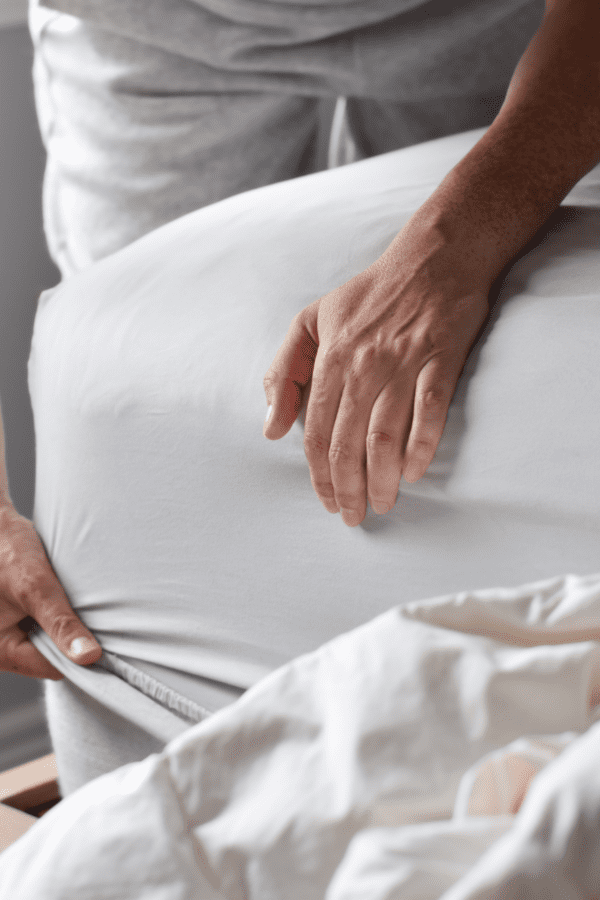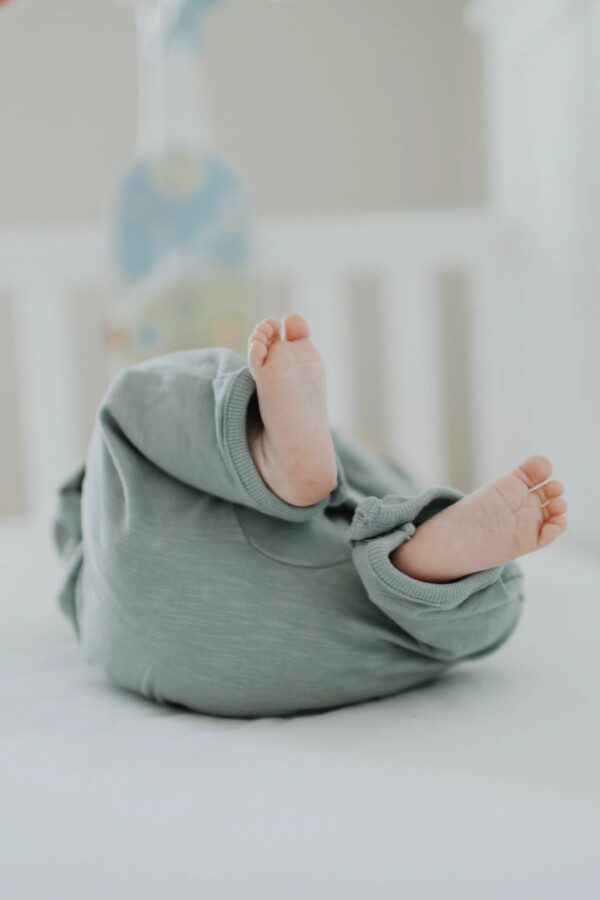Babies are more vulnerable to the effects of toxic chemicals for a few reasons:
1) They are still developing, which means that subtle alterations in their hormones (which can be caused by endocrine disruptors in plastics) can have larger impacts down the road.
2) Pound for pound, they eat, drink, and breathe more than adults (which means they’re ingesting “more” of the toxins in water, food, and air).
3) They tend to be on the floor more, where they pick up random toxicants, and then they put their hands in their mouths more, ingesting those toxicants.
For these reasons, many parents try to decrease the toxics their babies are exposed to as much as possible. It may be unrealistic to keep your little loved one away from all toxic chemical 100% of the time, but using non-toxic baby bottles is a relatively easy and low-cost thing you can do that can make a big difference.
So in this article, we’re talking about why plastic baby bottles are not ideal, which materials to look for instead, and which brands we recommend you check out.
Table of Contents
This article contains affiliate links, which means we may earn a commission if you decide to make a purchase. As always, all recommendations are vetted and honest.
Featured image credit: Pura
Are Plastic Baby Bottles Safe?
There are a few problems to consider when it comes to plastic baby bottles:
Bisphenols (like BPA)
Bisphenols are a class of chemicals that include acronyms you’ve probably heard of before, like BPA and BPS. These are usually used in plastics such as polycarbonate to make them stronger and more durable. The problem is that these chemicals are known endocrine disruptors, which means they can negatively effect one’s natural hormonal systems. BPA has been found to have effects even at low levels that have been determined as “safe” by government bodies and it has been shown to contradict the conventional adage that the “dose makes the poison.”
While endocrine disruptors are not good for anyone, they are especially concerning for babies since they’re still developing. A slight change in their hormones can have a big impact down the road. BPA has been linked to things like infertility, early puberty, PCOS, breast and prostate cancer, childhood asthma, and more.
Bisphenols like BPA can leach out of plastics at any time, but leaching increases in the presence of heat (like if you warm up milk/formula) and in the presence if fatty liquids (again: milk/formula). These chemicals can leach into the milk which of course is then ingested by baby.
You might say: “But they’ve taken the BPA out of baby bottles!”
That’s true. In many countries—including the U.S.—they’ve actually stopped using BPA in baby bottles.
Canada became the first country to ban BPA from baby bottles back in 2010. The U.S. followed in 2012 and many other countries have followed suit since. If you walk down the baby aisle at any big box store, you’ll probably see that basically every single brand has some sort of “BPA-Free” label on it.
While that’s definitely good progress, it only gets rid of ONE kind of bisphenol, when there are at least 200 other “cousin chemicals” that are very similar to BPA.
Companies can replace BPA with something like BPS or BPF, which is just as bad, and still slap a “BPA-Free” label on it.
And bisphenols are just one class of chemicals that’s found in plastic. There are also phthalates (which are generally found in softer plastics), dioxins, and other petroleum-based chemicals that can be found in microplastics—the microscopic plastic pieces that migrate from plastic consumer products and into the human body.
One study found that preparing formula in polypropylene bottles (which is actually a safer kind of plastic!) released microplastics “with values as high as 16,200,000 particles per litre,” that was at room temperature. Exposure to higher temperatures significantly increased microplastic release.
Scientists are still studying the direct correlation between microplastic ingestion and human health, but we already know it’s not good.
This is why “BPA-free” baby bottles aren’t always completely safe, and why you’ll ideally want to use bottles that are completely or almost plastic-free if possible.
(Most of the brands below use a little bit of plastic, mostly for the caps. Pura is the only brand that is 100% plastic-free.)
Lead
Another thing to consider when it comes to baby bottles is lead. In recent years, there have been several recalls of baby bottles which contain amounts of lead that exceed allowable limits.
Lead is a neurotoxin that can lead to things like delayed development, speech impairments, and lower IQ. Children are more vulnerable than adults to the negative effects of lead, and no amount of it is considered safe.
Recent baby bottle recalls due to lead have been because of two main problems:
- Paint on the outside of glass baby bottles (like what happened with NUK in July 2022).
- Lead solders on stainless steel baby bottles. (Which is what happened when Green Sprouts recalled over 10,000 bottles and sippy cups in late 2022. These bottles contained a lead solder which could be explosed if the bottom part of the cup became detached.)
The good news here is that it’s relatively easy to avoid lead in baby bottles by:
- Choosing glass baby bottles that do not have painting on the outside of the bottle (or at least as minimal paint as possible) and/or have been tested to be free from lead.
- Choosing stainless steel baby bottles from brands that either a) explicitly state that they do not use a lead solder anywhere in the bottle, and/or b) paying close attention to make sure the bottle stays in tact, and then getting rid of the bottle if it comes apart.
What is the Safest Material for Baby Bottles?
So now that you know what to be careful of when it comes to baby bottles, let’s look at your options for safer materials:
Glass
Glass is one of the safest options in terms of material. It doesn’t leach and if you can keep it in tact, it will last a really long time.
Most glass baby bottle brands use borosilicate glass, which is more durable, thermal shock resistant (able to withstand temperature changes), and resistant to chemical leaching and absorption.
Of course, there are obvious downsides to glass bottles as well: mainly that they’re breakable and heavier. To combat these cons, you can:
- Put a silicone sleeve over the glass bottle.
- Use glass at home and then use silicone and/or stainless steel when traveling.
Stainless Steel
Stainless steel bottles are another great option. It tends to be lighter than glass and is more durable.
There is some concern that stainless steel can potentially leach nickel or trivalent chromium (an essential mineral) when acidic liquids are used. (Breast milk and baby formula tend to be slightly acidic.) These metals are not considered toxic for most people except at very high amounts, which you’re not really likely to experience from bottle leaching. The only people who should be potentially mindful are those with a nickel sensitivity.
In other words, leaching isn’t really a big thing to worry about when it comes to stainless steel baby bottles. Just make sure you’re buying bottles that use food-grade stainless steel.
Silicone
Silicone has many of the same benefits plastic does in terms of usability: it’s lightweight, flexible, and durable.
So far, research indicates that silicone is safer than plastic, at least at cooler temperatures. However, there is some indication that at higher temperatures, some types of silicone can leach toxic chemicals. In general, we’re talking about baking temperatures (300-400° F), so this isn’t as much of an issue with breast milk and baby formula.
When shopping for silicone baby bottles, you’ll want to make sure it’s 100% food-grade or medical-grade silicone. If it’s not, it may have mystery plastic fillers in it, which could potentially contain the endocrine disruptors and other chemicals discussed above.
What About the Bottle Nipples?
For non-toxic baby bottle nipples, you’ll want to look for either silicone (100% food-grade or medical-grade) or natural rubber.
These days, most of the mainstream brands are using silicone for their bottle nipples (even if they use plastic for the bottle).
The Best Brands for Non-Toxic & Non-Plastic Baby Bottles & Nipples
Alright, now lets get to the best brands carrying non-toxic baby bottles so that you can choose the best one for your little one:
Mason Bottle

Price: $13-$20
Materials: Glass, silicone, stainless steel, plastic (lids)
Mason Bottle is a great low-waste option that can last you a really long time… Even after your baby grows up, you can use the bottles and jars for a variety of different things in your kitchen.
They have several different options, including a 4 or 8 oz glass bottle (the “Original”), a 16 oz stainless steel option, and an 8 oz all-silicone bottle. (You can get silicone sleeves for the glass bottles, but the all-silicone bottle is glass-free so it’s a good durable option for traveling.)
Their wide nipples have “FussFree” ventilation systems to reduce colic and are available in slow-, medium-, fast-, or flexible-flows. Mason Bottle says all of their products “have been extensively tested and are free of BPA, BPS, phthalates and lead.”
The only part of the Mason Bottle products that are plastic are the caps that go over the nipples/straws and the lids for the storage jars. (You can use regular metal lids for the storage jars if you’d prefer to go fully plastic-free. The plastic ones allow you to write on them and then wipe them off more easily.)
Their lids and nipples fit on most regular-mouth mason jars, too, so if you have a bunch of jars in your home already, you could just buy the nipples and caps and potentially save a bunch of money that way.
In addition to their baby bottles, they have gift sets, accessories, sippy cups for toddlers, and milk & food storage solutions.
Plus: Mason Bottle is serious about their customer satisfaction. Unlike most other brands, they allow you to return any product, at any time, for any reason.
Use the code THEFILTERY15 for 15% off.
Pura
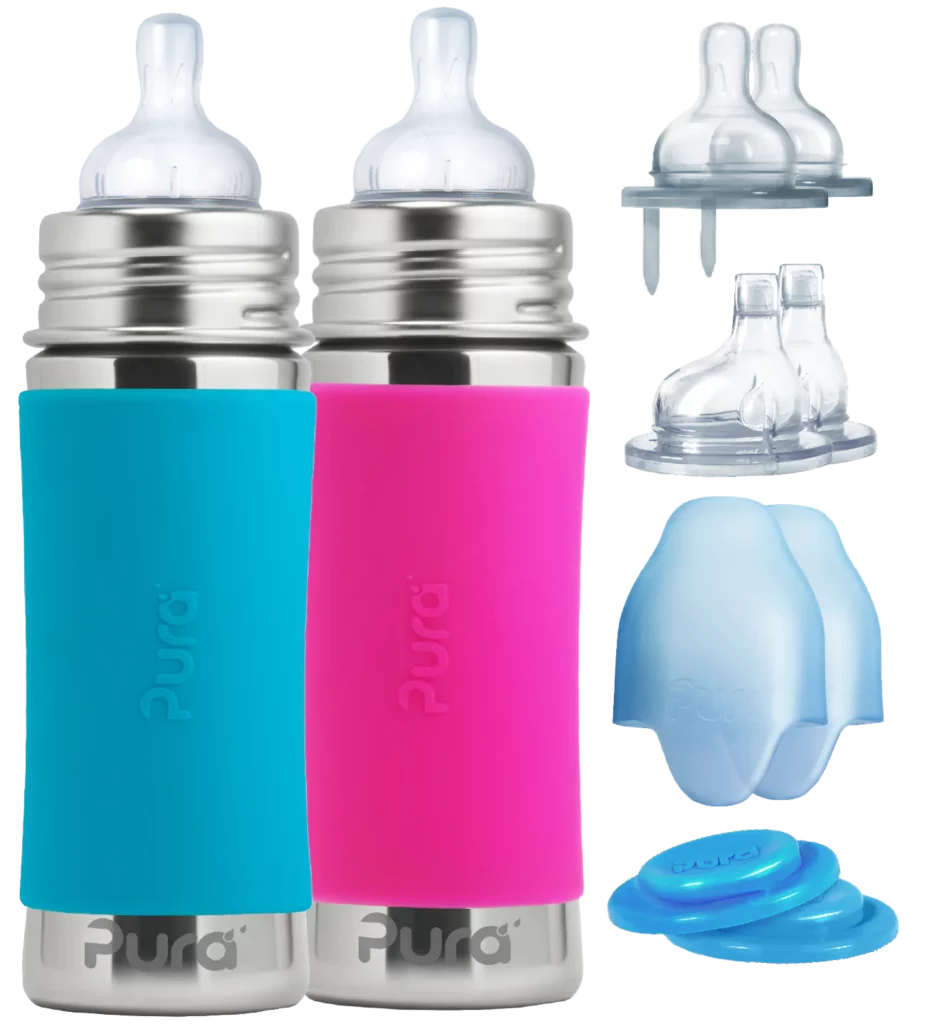
Price: $17-$50
Materials: Stainless steel and silicone
Pura is the only brand on this list that is MADE SAFE certified—one of our favorite third-party certifications. It’s also the only brand we’ve been able to find that is completely plastic-free—even the lids and caps! That means you don’t have to worry about phthalates, BPA, or other bisphenols. Not only that, but the silicone is all medical-grade and the stainless steel is food-grade.
Their infant bottles, which come in 5, 9, and 11 oz options, are made out of stainless steel and then covered with a silicone sleeve. They come with a Natural Vent Nipple™ with a wide shape and an anti-colic vent to prevent gas.
Pura’s bottles are very versatile, too. You can easily switch stuff around: all of the nipples fit onto all of the bottles and the silicone sleeves are interchangeable if you want to swap the colors. As your baby grows, you can swap out the nipple for a sippy cup lid, a straw, a sport/water bottle, or even a food storage container with a flat lid. So you can technically use the same bottle from baby to adulthood!
In addition to their baby bottles, they also have other products like 100% silicone sippy cups and snack packs, straw cups, and water bottles for big kids and adults.
Use the code THEFILTERY for 10% off.
Evenflo
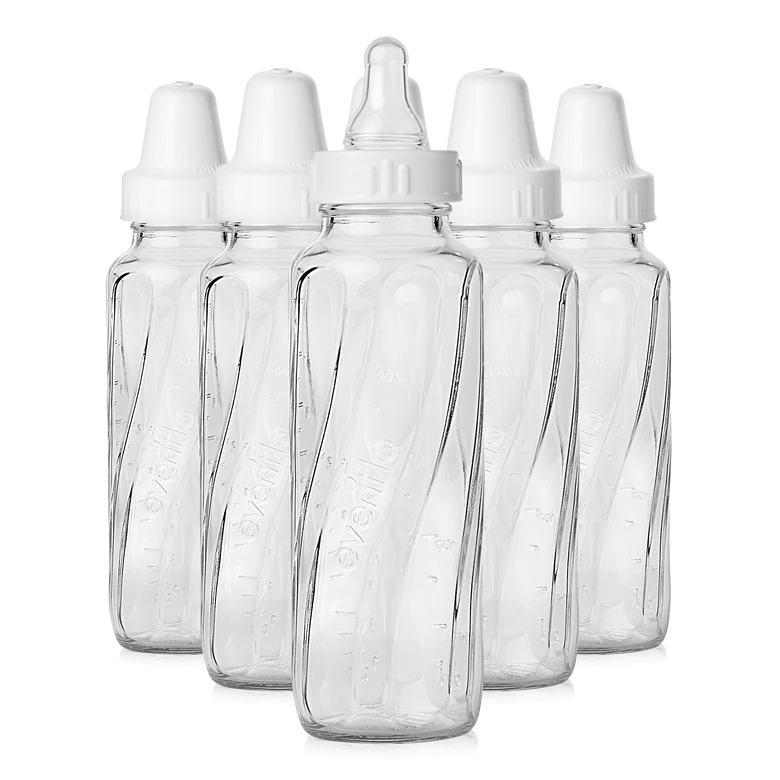
Price: $18.99 for a 6-pack of 8 oz bottles
Materials: Glass bottle with silicone nipples and plastic cap
Evenflo is a great option because they’re free from any paint and have grooves on the side for easier holding (for both parents and babies). They come in both 8 oz and 4 oz options.
The nipples are made with 100%, FDA-approved food-grade silicone and comes with micro air vents that help prevent nipple collapse. Evenflo offers a variety of different types of nipples that you can switch in and out of the bottles, including slow-, medium-, and fast-flows.
These bottles are also compatible with most breast pumps.
(They do have a plastic version of this bottle too, so just make sure you select the glass option if you order online.)
Shop at Target, Walmart, or Evenflofeeding.com
Life Factory
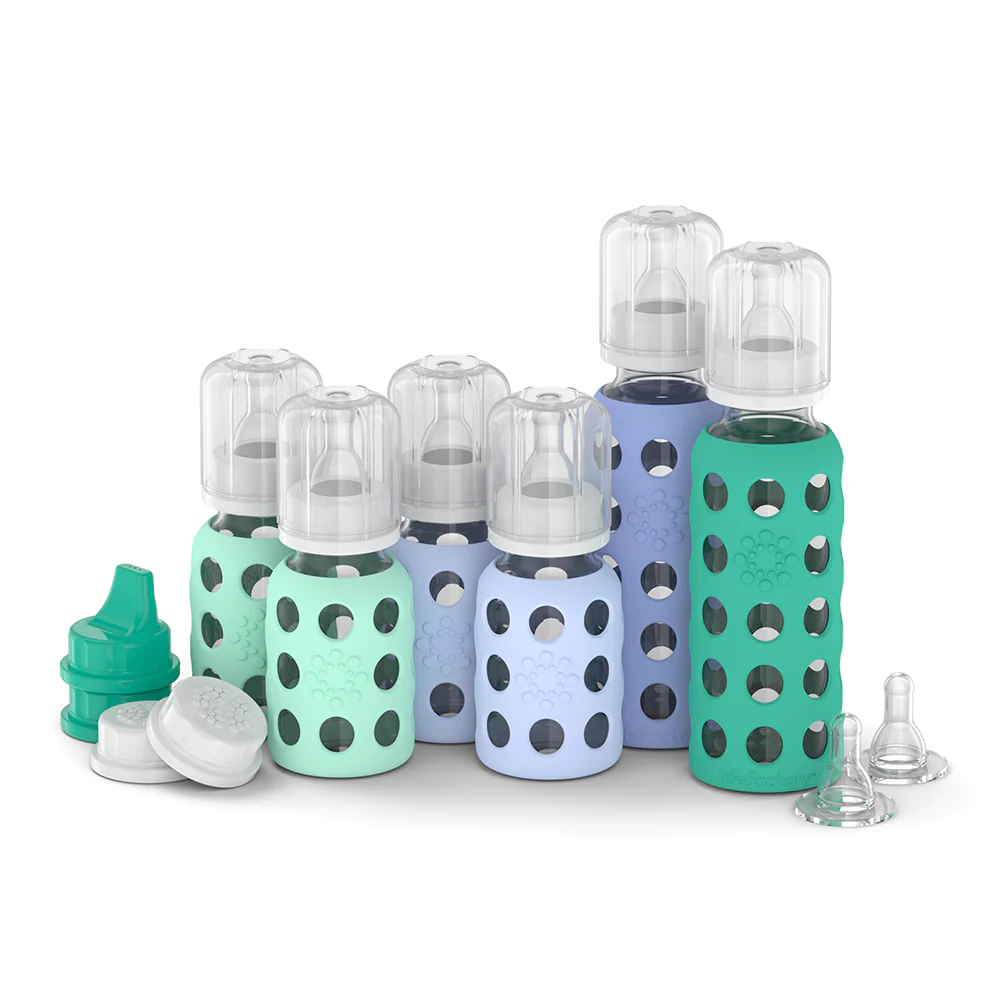
Price: $15-$28
Materials: Glass, silicone, stainless steel, and plastic (lids)
Life Factory has a lot of great options for baby bottles:
- narrow and wide neck
- glass and stainless steel
- various sizes (4, 8, and 9 oz)
- several types of nipples (standard, sippy spout, pivot straw)
- lots of color choices
For the bottles, you can choose between borosilicate glass or stainless steel. All of the nipples and sleeves are made out of silicone, and the caps are made out of polypropylene plastic. Life Factory says all of their bottles are tested to be free from BPA and phthalates, and they’re also free from paint.
Life Factory bottles are on the pricier side compared to some of the other brands, but they’re meant to grow with your child so you can get the maximum amount of use out of them. As your child grows from a baby to a toddler, you can transition from a regular nipple to a hard sippy spout, and then to a pivot straw cap. (These parts are also made with polypropylene plastic that’s tested to be free from BPA and phthalates.)
Life Factory also offers Starter Sets (a great thing to put on your baby registry!) and lots of accessories, too, including different kinds of nipples and flat caps.
Shop at Walmart or LifeFactory.com
Avent

Price: $13+
Materials: Glass, silicone, plastic (lids)
Avent by Philips offers several different kinds of glass baby bottles and are readily available at big box stores.
They offer 4 and 8 oz bottles with several different kinds of nipples. The “Natural Nipple” option is their original wide breast-shaped option, the “Natural Response Nipple” allows the baby to have more control over the flow and drinking rhythm, and the Anti-Colic nipple has a valve to decrease gas. (They also have anti-colic bottles with an internal vent system, but those bottles are made out of plastic.)
The glass bottles come with silicone nipples with some plastic around the cap. They also have silicone sleeves available. These bottles are compatible with most breast pumps as well.
These bottles do have a minimal amount of paint on them, but they’ve been tested to be lead-free.
Shop Avent at Target, Walmart, or Philips.com
HEVEA

Price: $32
Materials: Glass & natural rubber
This is a more unconventional bottle—it features a fun ball around it that makes it easier and more fun for baby to hold. And of course, it’s much less breakable since it’s surrounded by a bouncy ball!
The bottle itself is made out of 100% pure borosilicate glass, and the nipple and outer ball are both made out of natural rubber.
All of HEVEA’s products are made in Malaysia, where they source their rubber locally from their namesake: hevea rubber trees. They also carry other baby products made from natural rubber as well, like pacifiers, teethers, and toys.
Comotomo
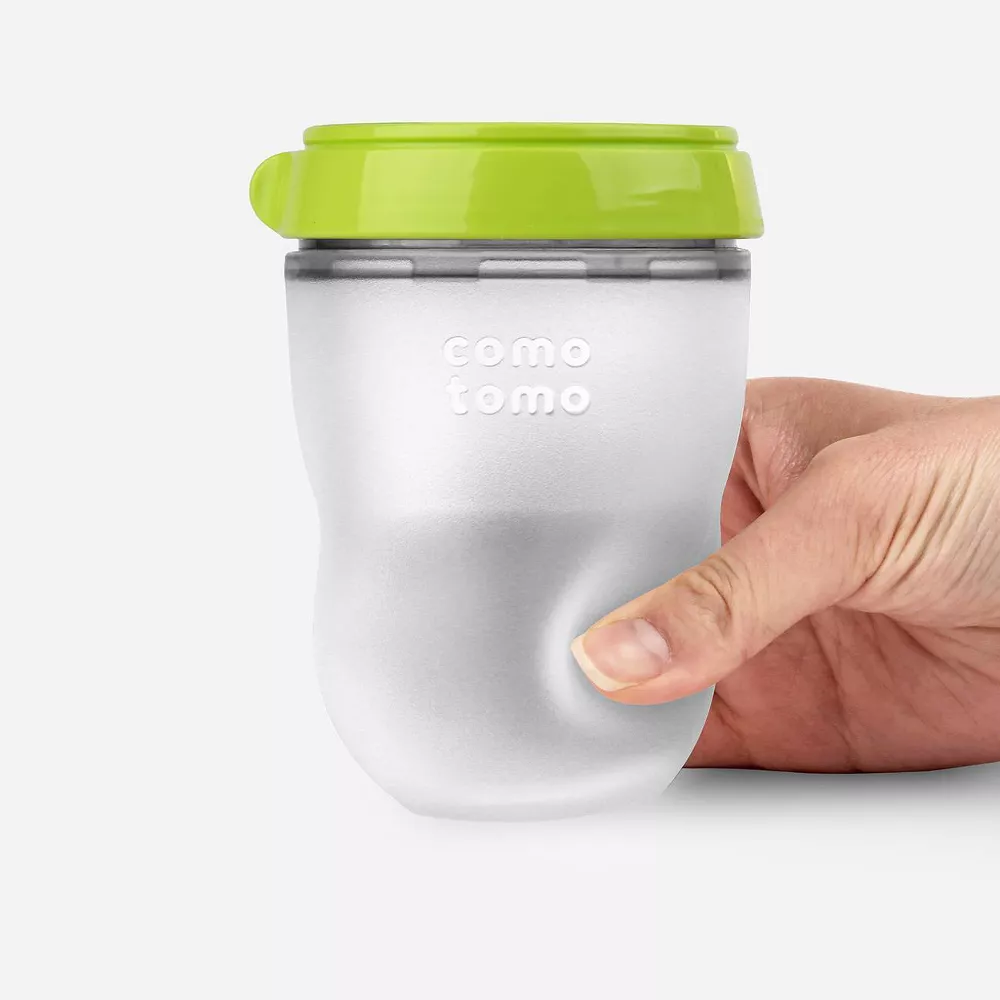
Price: $13+
Materials: Silicone
Comotomo baby bottles are from mostly silicone, making it a good option for traveling.
Comotomo’s silicone baby bottles are available in 5 or 8 oz options. They have wide nipples that are meant to mimic the shape of a breast and also have dual anti-colic air vents.
These bottles do contain a little bit of plastic on the ring and cap. (None of the plastic comes into contact with the liquid inside the bottle.)
What About Dr. Brown’s?

Price: $17-20 for a 3-pack
Materials: Glass, silicone, and plastic
Dr. Brown’s is a classic favorite among parents. Their Anti-Colic bottles feature an internal vacuum-free vent system that is clinically proven to reduce colic. They have a narrow option, which is your classic baby bottle shape, as well as a wide-neck option. Both types come with a breast-like nipple that’s made out of silicone.
It’s worth noting that the internal vent system (the green part that you can see in the image above) is made out of polypropylene plastic. This is not ideal, which is why we’d really only recommend Dr. Brown’s if you’re having a really hard time managing your baby’s colic and need to try a different kind of ventilation system.
To add a layer of protection for these glass baby bottles, you can purchase a silicone sleeve, which is available for both the narrow and the wide bottle.
Note that Dr. Brown’s bottles do have some paint on them, but it’s been tested for lead.
Dr. Brown’s sells plastic baby bottles as well, so just make sure you’ve selected the glass option before ordering.
Buy Dr. Brown’s at Target, Walmart, or drbrownsbaby.com.
More Non-Toxic Accessories for Baby Bottles
A lot of the brands above offer a variety of accessories that allow you to get the most out of your bottles—different lids, sleeves, handles, etc.
But you’ll also need a few other necessities…
ezpz has some great options for cleaning products, like a silicone bottle brush and a drying rack with removable pegs to hold your bottles.
(They also have a lot of tableware and sippy cups for toddlers and kids!)
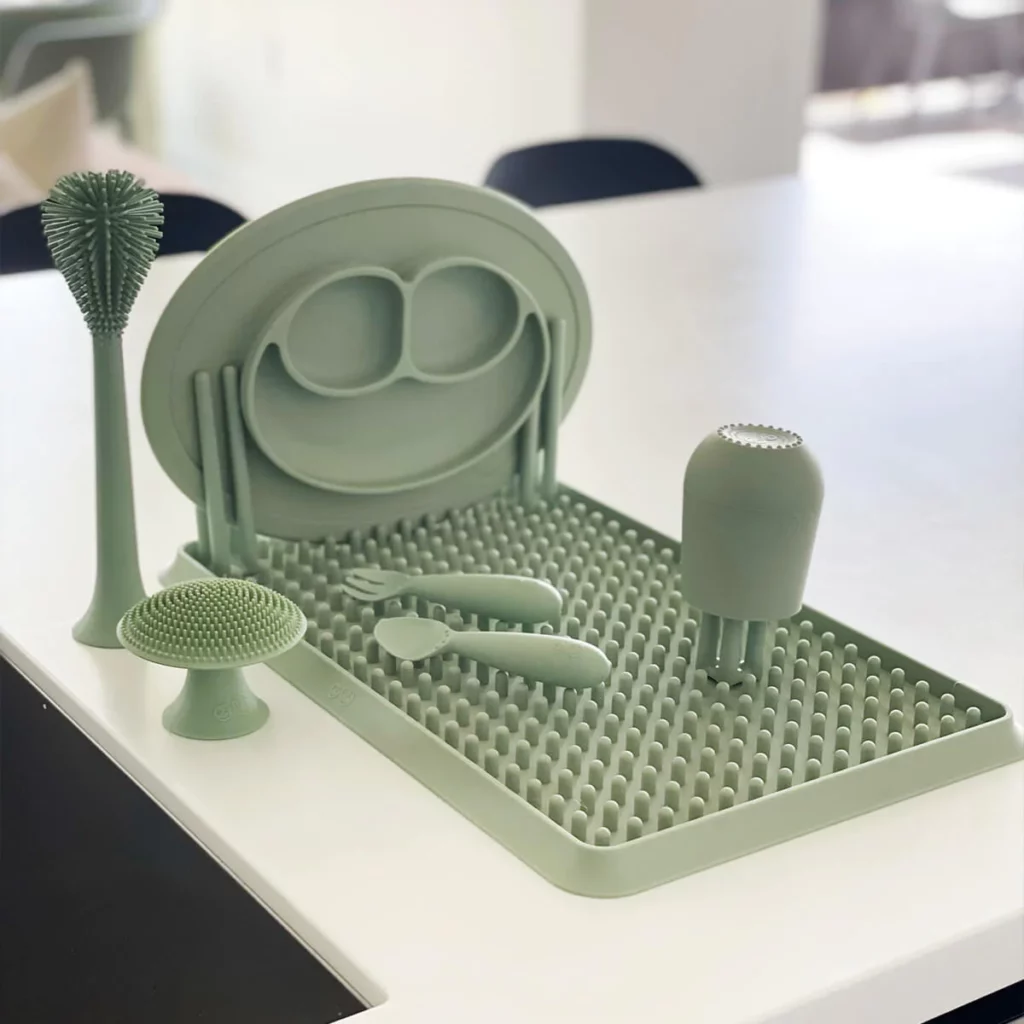
For baby-safe dish soap, we recommend Branch Basics or Healthybaby. (Or for even more non-toxic dish soap options, check out this guide.)
Many of the brands above also carry baby food storage options as well, but if you’re looking for some more guidance on non-toxic food storage, you can check out this guide.
Even More FAQs About Non-Toxic Baby Bottles
Are Tommee Tippee bottles non-toxic?
In addition to their plastic bottles, Tommee Tippee offers glass and 100% silicone baby bottles, which Tommee Tippee says are completely free from BPA and phthalates.
The two main reasons they didn’t make our “best of” list at this time are:
a) The bottles contain quite a bit of paint on the outside, and I haven’t been able to find any tests that confirm they are lead-free. (We’ll try and test them soon and update you!)
b) These bottles generally don’t have as positive of reviews compared to the other brands featured.
What About NUK Bottles?
Unfortunately, NUK bottles were recalled in 2022 due to lead so we cannot recommend them at this time.
Do glass bottles reduce colic?
Anecdotally, I’ve heard from parents that using glass baby bottles has helped reduce their baby’s colic, but I haven’t been able to find any evidence that this is true. Instead, ventilated nipples are more effective at preventing colic. (All of our recommended brands above employ an anti-colic vent of some kind.)
Are glass baby bottles microwave and/or dishwasher safe?
In general, glass baby bottles are microwave and dishwasher safe (usually top rack only), but we recommend following the directions for the specific brand in question.
Are stainless steel baby bottles dishwasher/microwave safe?
Stainless steel bottles should not go in the microwave. In general, they can go on the top rack of the dishwasher, but you should check with the specific brand to make sure.
What about silicone?
We recommend keeping silicone out of the microwave and/or dishwasher if possible since some research indicates that high heat can leach toxic chemicals from silicone.
Stay tuned for more non-toxic guides for your little ones, and sign up for Filtered Fridays to get notified via email when new guides are available!
RELATED ARTICLES:
- The best brands for non-toxic baby diapers, disposable wet wipes, and organic reusable wipes
- Where to find organic baby blankets and swaddles
- Organic & non-toxic pregnancy and nursing pillows



